Scottish Social Attitudes 2015: attitudes to discrimination and positive action
This report explores attitudes to discrimination and positive action in Scotland in relation to: age, disability, gender, race, religion, gender reassignment and sexual orientation.
This document is part of a collection
8. Equal opportunities and positive action
This chapter explores views on whether promoting equal opportunities for different groups has gone too far, whether people think that everyone has the right to equal pay and promotion opportunities regardless of gender or whether someone has a disability and attitudes to positive action.
Positive action is a set of practices which ensure that particular groups, which are disadvantaged in an employment context, gain equal access to employment or training opportunities. Under the Equality Act (2010) it is lawful for an employer to offer particular groups additional training or promotion if, for example, the number of employees from this particular group is low in their organisation. An employer can take the protected characteristics into account in recruitment if the candidates who are considered for the job are equally qualified.
Equal opportunities
SSA 2015 included questions, asked in SSA since 2002, on whether people feel that 'attempts to give equal opportunities' to different groups in Scotland have gone too far, not gone far enough or whether they are about right. [44] The three groups in question were women, 'black people and Asians' and 'gay men and lesbians'.
Overall, the most commonly held few was that 'attempts to give equal opportunities' were 'about right'. Fifty-five percent felt that attempts to give equal opportunities to lesbian and gay people were 'about right', 50% felt this about equal opportunities for women and 44% in relation to black people and Asians (see Figure 8.1).
The proportion who felt that equal opportunities have not gone far enough varied depending on the group in question. Around 4 in 10 (43%) felt 'attempts to give equal opportunities to women in Scotland' had not gone far enough and around 3 in 10 felt this with regard to black people and Asians (32%) and lesbian and gay people (28%). A small minority of people displayed negative attitudes towards promoting equal opportunities towards these three groups. Sixteen percent felt that 'attempts to give equal opportunities to black people and Asians' have gone too far and 10% expressed this view with regard to lesbian and gay people. The equivalent figure for women was only 3%. (See Tables A8.1-A8.2 in Annex A for details).
Figure 8.1 Attitudes to attempts to give equal opportunities (2015)
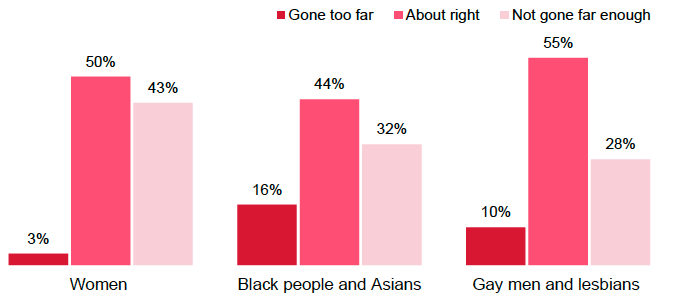
Base: All respondents
The proportion of people who felt that attempts to give equal opportunities have gone too far has decreased significantly since 2010 for all three groups. The most notable decrease was among those who felt attempts have gone too far for lesbian and gay people which declined from 20% in 2010 to 10% in 2015. And a similar pattern is seen with regard to views on equal opportunities for black people and Asians. However, the proportion of people who felt attempts have gone too far 'to give equal opportunities to gay men and lesbians' and 'black people and Asians' has not decreased steadily over time. Rather, as Figure 8.2 below shows, the proportion who felt equal opportunities for lesbian and gay people and black people and Asians have gone too far increased between 2002 and 2006, then remained at a similar level between 2006 and 2010 before decreasing in 2015.
Figure 8.2 Attempts to give equal opportunities to different groups in Scotland have gone too far (%, 2002-2015)
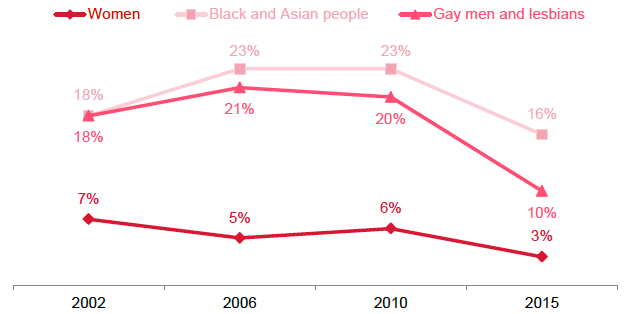
Base: All respondents. 2002=1665, 2006= 1549, 2010= 1495, 2015=1288
How do attitudes to promoting equal opportunities vary between groups?
Views on whether attempts to give equal opportunities to black people and Asians and lesbian and gay people have gone too far varied by socio-demographic factors, attitudes to diversity and knowing someone from a different racial or ethnic background. [45] (See Tables A8.3-A8.4 in Annex A for full details).
Gender, age, education, income and area deprivation
There were differences by age, education, income and area deprivation in views on whether attempts to give equal opportunities to black people and Asians and lesbian and gay people have gone too far. Gender was only significantly related to views on equal opportunities for black people and Asians. Specifically:
- Women were slightly more likely than men to think that equal opportunities for black people and Asians had gone too far (18% of women compared with 14% of men)
- Older people were more likely than younger people to think equal opportunities had gone too far for both black people and Asians and lesbian and gay people. For example, 21% of those aged 65 and over thought equal opportunities had gone too far for lesbian and gay people compared with only 1% of those aged 18-29.
- Those with lower levels of, or no, formal qualifications were more likely to think attempts to give equal opportunities had gone too far for both groups. For example, 31% of those with no formal qualifications thought equal opportunities for black people and Asians had gone too far compared with 11% of those educated to degree level.
- Those in the lowest income groups were also more likely than those in the highest incomes groups to think that equal opportunities had gone too far for both black people and Asians and lesbian and gay people. For example, 17% of those in the lowest income group compared with 7% in the highest income group thought that equal opportunities for lesbian and gay people had gone too far.
- Those living in the most deprived areas of Scotland were more likely than those in the least deprived areas to think that equal opportunities had gone too far for black people and Asians (29% compared with 10% respectively). The same was not evident with regard to views on lesbian and gay people.
Figure 8.3: Whether attempts to give equal opportunities to different groups went too far by age (2015)
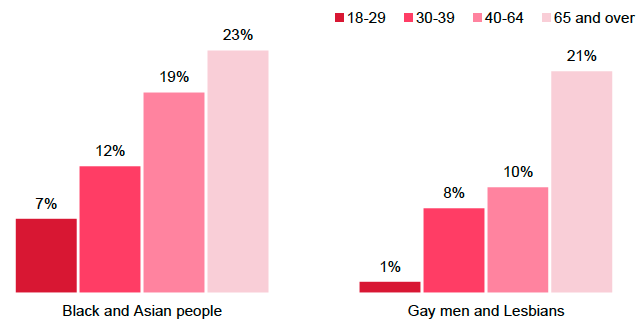
Base: All respondents
Religious affiliation
People's current religious affiliation was associated with more negative views about equal opportunities for lesbian and gay people, but not with regard to equal opportunities for black men and Asians. People who said they belonged to a particular religion were more likely to think that attempts to give equal opportunities to lesbian and gay people had gone too far (15%) compared with only 6% of those with no religious affiliation.
Attitudes to diversity and knowing someone from an equalities group
Two questions that explored people's general attitudes to diversity were also related to views on equal opportunities. Those who preferred to live in an area with people similar to themselves were more likely than those who preferred to live in an area with different kinds of people to think that attempts to give equal opportunities had gone too far for both black people and Asians and lesbian and gay people. For example, 19% of those who prefer to live in an area 'where most people are similar to you' thought equal opportunities for lesbian and gay people had gone too far compared with only 5% of those who prefer to live in an area 'with lots of different kinds of people'.
Similarly, those who thought that Scotland would lose its identity if more black and Asian people came to live here also held more negative attitudes about attempts to give both groups equal opportunities. For example, a third of those who agreed that Scotland would lose its identity if more black and Asian people came to live here said that equal opportunities had gone too far for black people and Asians compared with just 5% of those who disagreed.
Knowing someone from these two equalities groups was also associated with holding less negative views about attempts to give equal opportunities. For example, 8% of those who knew someone who is gay or lesbian thought that equal opportunities for lesbian and gay people had gone too far compared with 23% of those who did not know someone who is gay or lesbian.
Attitudes towards equal pay
SSA explored people's attitudes to equal pay for different groups of people living in Scotland. Women continue to be paid less than men, and disabled people are paid less than non-disabled people. In 2015, the median hourly earnings (excluding overtime) for men was £13.09 compared with £10.89 for women [46] , and disabled people earned £1.20 per hour less than non-disabled people. [47]
To explore people's views on equality in the work place SSA included two different scenarios, describing two different employees and asking respondents to decide whether one of them is more deserving of promotion or extra pay.
In the first scenario, respondents were asked to assess whether a woman who took a year off for maternity leave is equally deserving of a promotion as a female employee who had not taken any additional time off.
'Say that two women are being considered for promotion to a more senior position at work. Both have the skills needed for the job and both have worked for the company for five years. During that time one of the women took a year off work after having a baby.'
Nearly 9 in 10 (89%) thought that both women were equally deserving of a promotion. Only 1 in 10 people thought that the woman who had not taken a year off for maternity leave was more deserving of a promotion. Only 1% of people thought that the woman who had taken time off for maternity leave was more deserving of promotion.
SSA 2015 included two further scenarios exploring views on equal pay. The first described a woman working in a warehouse, a typically male-dominated workplace and the second described a man with a disability. Respondents were asked whether people felt it was right or wrong for these employees to be paid less than others. The two scenarios were:
'Say that a company employs two people full time to move and lift boxes of goods around a warehouse. One is a man, the other is a woman. The man is paid more than the woman. Do you think it is right or wrong that the man gets paid more than the woman?'
'Say that a company employs two men who do the same full time job. One has very poor eyesight, and he gets a grant from the government to pay someone to support him with doing things at work that are difficult due to his eyesight. The other man does not have poor eyesight and does not get such support. This other man gets paid more than the man with poor eyesight. Do you think it is right or wrong that the other man gets paid more than the man with poor eyesight?'
Figure 8.4 shows that over 9 in 10 (92%) considered it 'definitely' or 'probably wrong' that a man should be paid more than a women for moving and lifting boxes around a warehouse. Four percent said this was neither right nor wrong and a further 4% felt that it was 'definitely' or 'probably right' for the man to get paid more.
The majority of people also believed that it would be wrong if an employee without a disability was paid more than one with poor eyesight, just because the disabled employee received a government grant to pay someone to support him at work (65%). However, compared with views on the previous scenario where a woman was paid less than a man for doing the same job, a much greater proportion of people thought that it was right that the man without a disability is paid more. Nearly 1 in 7 (15%) thought that it was right that the other man gets paid more that the man with poor eyesight and a further 1 in 5 (19%) thought it was neither right nor wrong.
Figure 8.4: Attitudes to equal pay
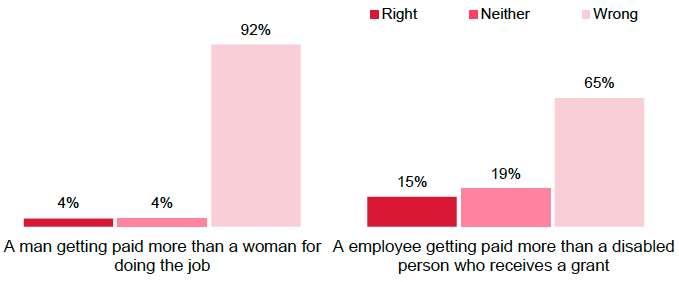
Base: All respondents
How do attitudes to equal pay vary between groups?
Although there were no significant differences between subgroups in relation to thinking that a man should get paid more than a woman, there was some variation with regard to those who were more likely to think that it is right for an employee to get paid more than another employee who has poor eyesight and is in receipt of a government grant (see Table A8.5 in Annex A for details). In particular, those who were more likely to hold this view were:
- Men (21% of men felt that it was right that an employee should get paid more than another employee with poor eyesight compared with 11% of women)
- Those with no formal qualifications (21% compared with 13% of those educated to degree level)
- Those who prefer to live in an area where people are similar to themselves (22% compared with 11% of those who would like to live with lots of different kinds of people)
Positive action
The Equality Act (2010) states that employers can, in certain situations, take steps to help specific disadvantaged groups access employment or training. This is referred to as positive action. Positive action is distinct from positive discrimination, which is unlawful.
SSA 2015 examined people's attitudes to whether it is fair or unfair to offer extra training opportunities to groups under-represented in senior jobs. It asked specifically about two groups - women and black and Asian people:
'Say a company had fewer women than men in senior jobs and decided to give its women employees extra opportunities to get training and qualifications. Do you think this would be fair or unfair?'
'And say a company had few black and Asian people in senior jobs and decided to give black and Asian people it employed extra opportunities to get training and qualifications. Do you think this would be fair or unfair?'
Overall, the majority of people were supportive of the idea of offering extra training opportunities to these groups if they were under-represented in senior jobs. Nearly two-thirds (65%) thought that it would be 'definitely' or 'probably fair' to offer women extra training opportunities and 57% were of the same opinion with regard to black and Asian people (see Figure 8.5).
Figure 8.5: Attitudes to women and black and Asian people being given extra opportunities to get training and qualifications
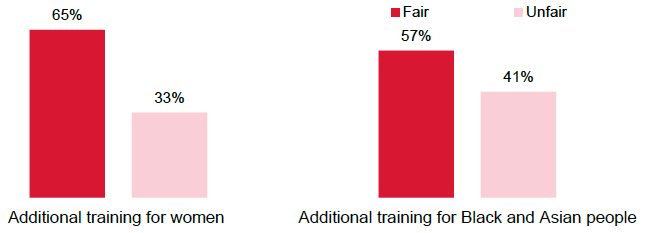
Base: All respondents
A considerable proportion of people, however, held a contrary view. A third of people (33%) thought that it would be unfair to offer female employees extra training opportunities if they were under-represented in senior jobs and two in five (41%) held this view in relation to black and Asian people
SSA also asked people their views about certain recruitment practices. First, they were asked what they thought about a person with a disability being automatically offered a job interview. Respondents were asked:
'Say several people apply for a job, including someone with a disability. They all meet the necessary requirements for the job. Do you think it would be fair or unfair to automatically give the person with a disability an interview for the job even if other candidates appear to be better qualified?'
Second they were invited to consider women-only shortlists, based on a description of what is currently illegal practice in the UK (women-only shortlists for political candidates are not, however, illegal):
'Say a company has very few women in senior jobs. They are about to recruit a new senior manager and decide they want to appoint a woman. Do you think it would be fair or unfair for the company to only interview women for the new job?'
Figure 8.6 shows that people in Scotland were less supportive of positive action in recruitment than they were of providing extra training opportunities. Overall, only 2 in 5 felt that it would be 'definitely' or 'probably fair' to grant an automatic job interview to a disabled person and only 1 in 5 thought it would be fair to only interview women for a new job in a company where there were not enough women in senior jobs. (See Tables A8.6-A8.7 in Annex A for details).
Figure 8.6: Attitudes to positive action in recruitment - granting an automatic job interview for a disabled person and shortlisting only female candidates
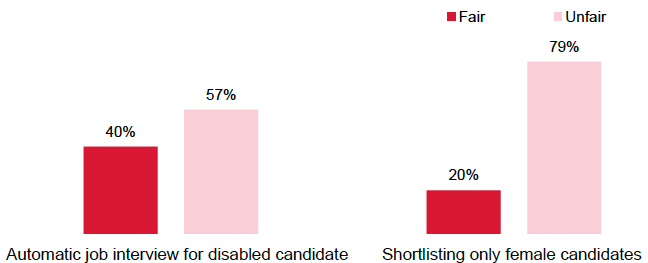
Base: All respondents
Previous chapters have shown considerable change over time, with more positive attitudes being recorded in 2015 than ever before. However,people's attitudes to positive action have remained almost unchanged since the questions were first asked in 2006.
As Figure 8.7 shows, in 2010 it seemed that people's attitudes towards positive action were becoming more negative. For example, the proportion of people who felt that it was unfair to offer black and Asian people extra training and qualifications increased from 41% in 2006 to 48% in 2010. However, the proportion declined in 2015 to the same proportion as held this view in 2006 suggesting that people's views in 2010 might have been influenced by the economic recession and increased competition for jobs. [48]
Figure 8.7 Believing it is 'definitely' or 'very unfair' to have a policy of positive action in relation to certain groups (2006-2015)
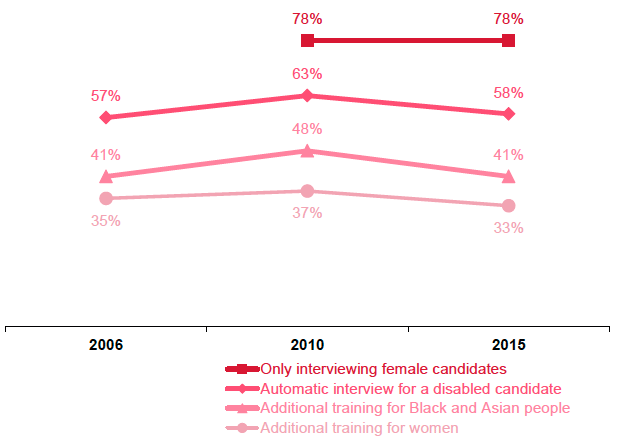
Base: All respondents
How do attitudes to positive action vary between groups?
The groups who were more likely to oppose positive action measures differ from those who have been shown to hold discriminatory views in the preceding chapters of this report. Those who were more likely to say that offering extra training opportunities to women and black and Asian people was 'definitely' or 'probably unfair' included men, younger people (particularly those aged 18-29), people educated to degree level and those in the highest income group. In addition employers were less supportive of giving extra training to women (45% of employers compared with 23% of those in semi-routine and routine occupations) as were people in work (45%) compared with those who are retired (34%). [49] (See Table A8.8-A8.9 in Annex A for details).
Views on whether it was unfair to offer extra training to black and Asian people also varied by measures that highlighted a more general prejudice against black and Asian people. Around half (47%) of those who agreed that if more black and Asian people came to Scotland it would begin to lose its identity thought that offering black and Asian people extra training was unfair compared with 37% who disagreed that Scotland would lose its identity. And those who would prefer to live in an area with less diversity were also more likely to say it was unfair to give black and Asian people extra training opportunities. Forty-five percent of those who preferred to live in an area where people are similar to themselves said it was unfair to give black and Asian people extra training opportunities compared with 38% who preferred to live in an area with lots of different kinds of people.
Those more likely to think that granting an automatic interview to a person with a disability was unfair included people aged 18-29, those educated to degree level, those in work, those in the highest income group and those living in the least deprived areas (see Table A8.10 in Annex A for details). [50] In particular, those who were more likely to say that it was 'definitely' or 'probably unfair' to automatically give a person with a disability an interview for a job were:
- People aged 18-29 (70% compared with 43% of those aged 65 and over)
- People educated to degree level (62% compared with 43% of those with no formal qualifications)
- People in the highest income group (61% compared with 51% in the lowest income group)
- People living in the least deprived areas (64% compared with 47% of those in the most deprived areas)
- People in work (63% compared with 44% of those who are retired)
- People who do not have a disability (60% compared with 53% of people with a disability)
Contact
There is a problem
Thanks for your feedback